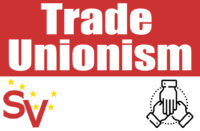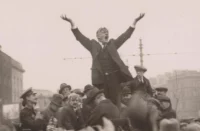The problems facing organised labour in Ireland—declining density, lack of younger members, difficulty engaging contract workers, depleted funds, hostile media coverage, etc.—are well known and familiar to all those involved in the movement today.
Many people have posed rather sensible responses to these issues, such as a better use of social media to engage younger workers and shape media narratives, single-day strikes to conserve funds, etc.
While each of these initiatives should and must be part of a wider strategy for the rebuilding of the labour movement, they fall into the same trap that the Democratic Party of the United States finds itself in. By puttering about the edges with piecemeal fixes and without looking at the bigger picture, the labour movement can only hope to delay rather than reverse its long-term decline.
It is time that those of us on the left began looking at the systemic factors that have led to the adverse epiphenomena of declining union power. Unfortunately, we have thus far failed to do so as a movement, and instead of analysing the system of industrial relations in Ireland we have merely looked to its outward manifestations.
A recent article in Socialist Voice, headed “The wrong act?” is symbolic of this myopic thinking on the future of the trade union movement. By proposing right to access (not in itself a bad idea) as the focus of rebuilding the trade union movement, it falls into the persistent pattern of proposing technocratic solutions to political problems. It is a case of once again failing to see the wood for the trees.
Industrial paradigms
Any solution to the problems faced by the Irish labour movement (or indeed any other labour movement) must begin by recognising that this problem did not develop yesterday, nor is it a temporary blip: instead it is the continued working out of the existing paradigm of industrial relations, a paradigm that may be called, for lack of a better phrase, social partnership.
While “social partnership,” in its strictest sense, refers only to the specific centralised bargaining agreements carried on between the state and IBEC, the ICTU, and others, it has broadly set the pattern for the conduct of industrial disputes since the late 1980s. The state is seen as a neutral arbiter in the perennial dispute between labour and capital, and any and all disputes should be mediated through the organs of the state, whether it be the Labour Court or the Workplace Relations Commission.
This, together with a whole host of labour laws, determines the existing paradigm of industrial relations in Ireland.
This paradigm has defined the very nature of industrial struggle for the past few decades. Industrial disputes were largely filtered through the state apparatus, and the political action of the trade union movement was reduced to campaigning for more Labour Party TDs. This framework also hastened the development of the “trade unions as service” model, an attitude that severely curtails trade union activism.
In fact this paradigm has been so successful in moderating discord that even after the state reneged on its side of social partnership after the Great Recession, the labour movement has remained sitting at the table, waiting for it to return.
If we are serious in our goal of reversing the secular decline in union power, it will inevitably mean breaking entirely with the current paradigm of industrial relations. We can no longer just engage in technocratic fixes within that system but must seek to circumvent it.
One major example of this circumvention in recent years has been the labour movement’s involvement in the Right2Water struggle. Initiated by local community groups and supported and nurtured by the trade union movement, R2W worked outside the usual channels of social partnership, and achieved the greatest political victory of the trade union movement since the economic collapse.
Even here, however, after the initial campaign, political strategy quickly reverted to type, and energy was concentrated on the election of TDs through Right2Change, a strategy that had very few returns. A more systematic approach is needed—one that challenges the idea of a supposedly neutral state mediating the economic struggle.
Strategy
What are the outlines of such a strategy? To gain some clarity on this, it is worth examining the “right to access” proposal and its consequences.
Technical fixes
In the face of declining industrial density and the accompanying decline in union finances, “right to access” modelling on the Australian and New Zealand models seems like a promising strategy. By allowing organisers to enter work-places and gain new members one neatly solves both issues of declining membership and difficult-to-mobilise sectors. Such a move would allow the unions to halt their decline and bolster income while engaging a wider sector of the population.
Like so many vaunted panaceas, however, there are serious side-effects.
“Right to access” would not in any way challenge the existing corporatist paradigm of social partnership; nor would it challenge the existing behaviour of trade unions. By refusing to challenge the structures of industrial relations, “right to access” instead entrenches them. It removes any necessity for unions to develop alternative means of reaching out to new members (such as social media initiatives and building organic community links) and instead allows them to continue to operate on the “trade union as service” model. By failing to build independent political power within the trade union movement, and by failing to challenge the overall paradigm within which our struggle is conducted, “right to access” merely sets us up to win more battles in a war we will lose anyway.
Furthermore, it is not clear what exactly such a strategy would look like in practice. While “right to access” is a laudable end, the means of getting there are unclear. Certainly such a policy cannot be enacted at the local level, and it is inconceivable that popular political pressure can be brought to bear as in the water campaigns. The only obvious means of proceeding would be to lobby TDs and councillors to push for legislation. Indeed the writer of the article more or less explicitly recognises this when he suggests that our hope lies in a favourable Sinn Féin government coming to power.
If the only strategy for reversing the secular and systemic decline in labour’s political and economic power is to hope for an amenable Government, the trade union movement is already doomed. Such a strategy would make the unions an adjunct of Sinn Féin’s political strategy, and would reduce our political action to electoral campaigning for Sinn Féin TDs once every five years. We have already seen the outcome of this strategy in relation to the Labour Party, which had some organic links with the labour movement. In contrast, if the unions believed they had any power over the Labour Party, they will have exactly none over Sinn Féin.
Not only would the technical fix of “right to access” legislation fail to resolve the political problem of union stagnation, it would also disincentivise the unions from building their own political power and instead would leave us with nothing but the vain hope that a friendly Government might some day come along while we twiddle our thumbs.
If it’s not broken, don’t fix it
Is there an alternative to a legislative strategy? To find inspiration on this front we can turn to the United States.
Up to the 1990s the US Congress was dominated by the Democratic Party. Decade after decade, voters would return their Democratic representatives to their seats, and approval ratings remained high.
Faced with this political problem, Newt Gingrich, a hatchet man of the US right wing, devised a simple strategy. While his Republican Party colleagues sought to campaign more effectively or to spend more money on television ads, Gingrich recognised that the American people felt the Congress was working and therefore there was no need to change it. In other words, they felt “if it’s not broken, don’t fix it.”
The natural corollary of this proposition is that if you want someone to fix something you should first break it. And this is precisely what Newt Gingrich did.
By convincing his colleagues to use every legal and procedural trick in the book, Gingrich managed to completely gum up the workings of the House of Representatives, leaving it totally dysfunctional. Approval ratings plummeted, as voters wanted change, and for the first time in forty years the House of Representatives flipped to the Republican Party.
Gingrich recognised that under the prevailing system of political relations the Republicans could not hope to win control, no matter how well they played that particular political game. What was needed was a new system, a new game; and that required breaking the old one.
Exactly the same situation faces us here in Ireland today. We are locked in a political game that we have been slowly losing for decades. It is not enough to play this game better, or find small technical fixes to the rules. What is needed is an entirely new game. What is needed is to challenge the entire paradigm of industrial relations. That is, we need to systematically dismantle the entire architecture of industrial relations in Ireland.
Dismantling the Industrial Relations Act
As communists, we recognise that the state is not a neutral actor. The state acts as an instrument of class oppression, and any strategy must remain cognisant of this fact and directly challenge both the ideological and the legal role of the state in labour disputes.
This is not achieved merely through intra-parliamentary means but through changing facts on the ground. The law is nothing more than congealed politics; and if we wish to change the law, one crucial element is changing the underlying realities.
The Industrial Relations Act (1990)—inclusive of its various updates—did not inaugurate, or define, “social partnership” but rather is its crowning achievement. By criminalising the most effective tools in labour’s arsenal while simultaneously building a mediating structure for resolving labour disputes, the Industrial Relations Act is the capstone of social partnership and the linchpin in the existing regime of labour relations.
How does one challenge this act and, by extension, the existing industrial paradigm? Demanding a straight repeal runs into many of the same problems of dependence on political parties and the state; so instead what is needed is a direct assault on the legislation itself. Instead of lobbying for repeal of the act in its entirety, the trade union movement should identify and isolate key areas of the act that can be circumvented by extra-legal means.
Much like Gingrich’s strategy to dismantle the US Congress, unions need to begin operating outside the rules of the game.
To offer a concrete example of such a circumvention strategy: at present it is illegal to establish a picket line within a shopping centre. Strikers are forced to stand far beyond the entrance to the centre, rendering the picket much less effective than it could be.
One means of dealing with this is to attempt to amend the legislation through TDs etc. Another, more effective means is to recognise that, while the legislation may prevent a union from entering and picketing within the shopping centre, there is nothing to prevent a community group from entering the centre and protesting outside the particular shop.
Such a tactic would shelter the union from legal repercussion while also bringing pressure directly to bear upon the dispute in question. By such means, the unions could simultaneously weaponise their strikes to a greater extent (so saving money with shorter disputes), build community relations, build their independent political power, and win more strikes (all aspects missing from a TD-lobbying approach).
These tactics also allow us to engage shop stewards and ordinary members in the struggle, and allow for immediate results in current campaigns.
This line of attack—of systematically identifying troublesome sections of the legislation and engaging resources to circumvent them—would serve to nullify the law, piece by piece. By targeting the structure of industrial relations in this way we can build independent union political power and loosen the restraints on the labour movement.
Our rallying cry must be that what we cannot nullify de jure we must nullify de facto. If they won’t fix it, we must break it.
Conclusion
The labour movement finds itself at a crossroads. It can either continue to operate within the existing structure of industrial relations and search for ever more technical fixes, or it can recognise that what is needed is a paradigm shift and tackle those structures head on.
The choice is further made concrete by the proposals before us of challenging the Industrial Relations Act or of lobbying for right to access.
One choice will lock the trade union movement into an electoral strategy, mortgaging its hopes on Sinn Féin. The other seeks to build independent union power, engage in immediate struggles, and overhaul the existing norms of labour relations.
By challenging the linchpin of social partnership we also bring into question the role of the state in the economic and political struggles we face. It is no longer enough to tinker around the edges: we need to begin to dismantle the entire paradigm of social partnership.
Never has the choice been starker. We must go political or go home.






